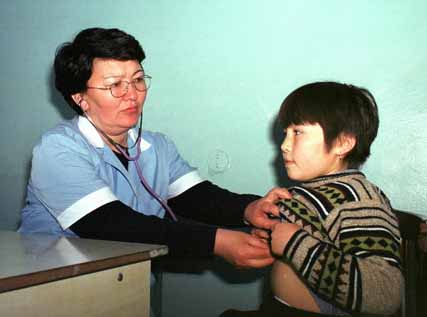Hiroshima Memo: The High Costs of Nuclear Testing
Mar. 10, 2008
by Akira Tashiro, Executive Director of the Hiroshima Peace Media Center
In July 1946, almost a year after the atomic bombings of Hiroshima and Nagasaki, the United States conducted the first nuclear test of the post-war period at the Bikini Atoll in the Marshall Islands, located in the middle of the Pacific Ocean. The United States went on to perform a total of 66 atomic and hydrogen bomb tests at Bikini Atoll and Enewetak Atoll until this testing was halted in 1958. The Bikini Incident, in which the Japanese fishing boat “The Daigo Fukuryu Maru” (“The Lucky Dragon No. 5”) was exposed to nuclear fallout, was a consequence of one of these tests.
At the same time, the former Soviet Union was urgently trying to catch up with the United States in the nuclear arms race. It conducted its first atomic bomb test in August 1949 at the Semipalatinsk nuclear test site, which extends over a broad plain in Kazakhstan. Until 1990, when the test site was closed down, the Soviet Union carried out as many as 466 nuclear tests, both atmospheric tests and underground tests.
Half-a-century has passed since nuclear testing was suspended in the Marshall Islands and the tests held in Semipalatinsk ended nearly twenty years ago. Yet the grim destruction left behind by this nuclear testing still lingers.
The radioactive fallout--the “ashes of death”--from these nuclear tests has caused wide-ranging suffering: crewmembers of the Daigo Fukuryu Maru, inhabitants of the Marshall Islands, and residents near the nuclear test site in Semipalatinsk. In fact, the people who continue to live in these contaminated areas have been exposed to radiation daily, over many years, both externally and internally through the food chain. The stealthy effects of this invisible radiation have not only deprived people of their health, even their lives, they also threaten generations born after the nuclear testing ended.
In Hiroshima and Nagasaki, a health survey of second generation A-bomb survivors has so far turned up no significant physiological differences between these subjects and people who bear no legacy from the bombings. However, environments like the Marshall Islands and Semipalatinsk reveal that the consequences of radiation exposure ultimately depend on the nature of that exposure.
When I was interviewing villagers around the Semipalatinsk test site in 2001, a female doctor, who suffers from anemia and other health problems herself, told me: “Compared to the atomic bombings of Hiroshima and Nagasaki, the effect on the second generation here is more apparent in terms of congenital conditions and cancers.”
Considering, too, the tens of thousands of American and Russian soldiers who have undoubtedly also been affected by nuclear testing, the costs of nuclear tests conducted in the name of “national security” are dreadfully high.
In July 1946, almost a year after the atomic bombings of Hiroshima and Nagasaki, the United States conducted the first nuclear test of the post-war period at the Bikini Atoll in the Marshall Islands, located in the middle of the Pacific Ocean. The United States went on to perform a total of 66 atomic and hydrogen bomb tests at Bikini Atoll and Enewetak Atoll until this testing was halted in 1958. The Bikini Incident, in which the Japanese fishing boat “The Daigo Fukuryu Maru” (“The Lucky Dragon No. 5”) was exposed to nuclear fallout, was a consequence of one of these tests.
At the same time, the former Soviet Union was urgently trying to catch up with the United States in the nuclear arms race. It conducted its first atomic bomb test in August 1949 at the Semipalatinsk nuclear test site, which extends over a broad plain in Kazakhstan. Until 1990, when the test site was closed down, the Soviet Union carried out as many as 466 nuclear tests, both atmospheric tests and underground tests.
Half-a-century has passed since nuclear testing was suspended in the Marshall Islands and the tests held in Semipalatinsk ended nearly twenty years ago. Yet the grim destruction left behind by this nuclear testing still lingers.
The radioactive fallout--the “ashes of death”--from these nuclear tests has caused wide-ranging suffering: crewmembers of the Daigo Fukuryu Maru, inhabitants of the Marshall Islands, and residents near the nuclear test site in Semipalatinsk. In fact, the people who continue to live in these contaminated areas have been exposed to radiation daily, over many years, both externally and internally through the food chain. The stealthy effects of this invisible radiation have not only deprived people of their health, even their lives, they also threaten generations born after the nuclear testing ended.
In Hiroshima and Nagasaki, a health survey of second generation A-bomb survivors has so far turned up no significant physiological differences between these subjects and people who bear no legacy from the bombings. However, environments like the Marshall Islands and Semipalatinsk reveal that the consequences of radiation exposure ultimately depend on the nature of that exposure.
When I was interviewing villagers around the Semipalatinsk test site in 2001, a female doctor, who suffers from anemia and other health problems herself, told me: “Compared to the atomic bombings of Hiroshima and Nagasaki, the effect on the second generation here is more apparent in terms of congenital conditions and cancers.”
Considering, too, the tens of thousands of American and Russian soldiers who have undoubtedly also been affected by nuclear testing, the costs of nuclear tests conducted in the name of “national security” are dreadfully high.








